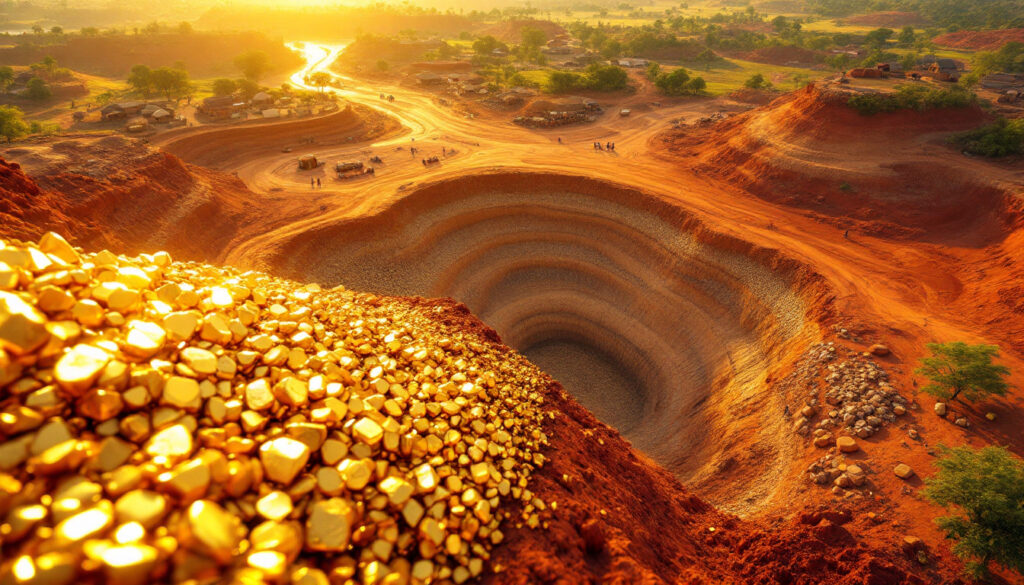Gold Fields Damang Mine Closure in Ghana: Impact and Implications
The closure of Gold Fields' Damang Mine represents a significant turning point in Ghana's mining landscape, reflecting both regulatory changes and strategic corporate decisions. With operations ceasing and a mandated exit approaching, this development highlights evolving dynamics between multinational mining companies and resource-rich nations seeking greater control over their natural wealth.
What Led to the Closure of Gold Fields' Damang Mine in Ghana?
The primary catalyst for the Damang mine closure was the Ghanaian authorities' rejection of Gold Fields' application for a 30-year lease extension. The Minerals Commission of Ghana formally notified Gold Fields that their request had been denied, despite the company's assertions that they had fulfilled all statutory requirements for renewal.
The notification came as a significant blow to Gold Fields, which had operated the mine for decades and anticipated continued operations. According to industry analysts, this rejection reflects Ghana's increasingly assertive stance toward foreign mining companies and growing resource nationalism across West Africa.
The ownership structure of Damang mine highlights the complex stakeholder environment: Gold Fields Ghana holds a 71.1% stake through Abosso Goldfields, IAMGold maintains an 18.9% ownership position, and the Ghanaian Government retains a 10% interest. This mixed ownership structure, common in Ghana's mining sector, did not ultimately safeguard against the lease non-renewal.
"We have been instructed to cease all operations and vacate the premises by April 18, 2025," stated Gold Fields in their official response, emphasizing their commitment to "ensuring the safety and security of all personnel during this transition period."
Mining law experts note that Ghana's stance represents a significant shift from previous decades when lease renewals were typically granted to companies with established operations, signaling a new era in Ghana's resource governance approach.
What Are the Key Facts About the Damang Mine?
Damang mine encompasses an impressive 8,111 hectares of mineral-rich land in Ghana's Western Region. The property consists of five prospecting licenses and two mining leases, representing significant geological potential that has been exploited since the 1990s.
Active mining operations at Damang ceased in 2023, marking the beginning of the end for what was once one of Gold Fields' important West African assets. The company's geologists estimate that remaining reserves stood at less than 0.5 million ounces by late 2023, contributing to the mine's declining production profile.
Since the halt of active mining, operations have focused exclusively on processing stockpiles as part of a planned end-of-life strategy. This approach is typical for aging mines, allowing companies to extract remaining value while preparing for eventual closure.
The Damang mine's geology is characterized by its Tarkwaian and Birimian rock formations, which have historically yielded gold grades averaging 1.8 grams per tonne. Recent gold market analysis indicates that such grades are becoming increasingly valuable as global reserves diminish. At its peak in 2018, the mine produced approximately 240,000 ounces of gold annually, though production had steadily declined in recent years.
With the April 18, 2025 deadline to vacate the premises approaching, Gold Fields has accelerated its decommissioning processes, including environmental rehabilitation activities and community transition programs.
How Is Gold Fields Responding to the Closure?
Gold Fields has implemented comprehensive safety and security protocols for personnel remaining at the Damang site during the wind-down period. These measures include scaled-back operations, reduced workforce presence, and enhanced site security.
The company continues to engage with Ghanaian governmental authorities, seeking clarity on the reclamation requirements and post-mining obligations. According to industry sources, Gold Fields has allocated approximately $45 million for site rehabilitation and environmental restoration.
Strategically, Gold Fields is pivoting away from older assets like Damang toward higher-potential projects. The company has directed significant resources toward the development of the Salares Norte mine in Chile, which represents a $860 million investment and is expected to produce 450,000 ounces of gold equivalent annually once fully operational.
In a major strategic move, Gold Fields acquired Osisko Mining for $1.39 billion in 2024, securing the promising Windfall project in Canada. This acquisition underscores the company's shift toward politically stable mining jurisdictions with high-grade deposits.
"The Windfall acquisition positions Gold Fields for high-margin, long-term growth in a tier-one jurisdiction," explained CFO Paul Schmidt in a recent investor briefing. This statement highlights the company's strategic realignment away from politically uncertain regions toward more predictable operating environments.
Despite the Damang closure, Gold Fields maintains its commitment to Ghana through continued operations at its larger Tarkwa mine, which contributed approximately 526,000 ounces to the company's production in 2024—representing 22% of Gold Fields' global gold output.
What Are the Broader Implications for Ghana's Mining Sector?
Ghana's handling of the Damang mine lease represents part of a broader regulatory overhaul in the country's mining and gold trading sectors. The government has directed all foreign entities involved in gold trading to exit these activities by April 20, 2025—a timeline that aligns closely with Damang's mandated closure.
Central to this reform is the establishment of the Ghana Gold Board (GoldBod), which will centralize all gold purchasing, selling, assaying, and export activities in the country. This centralized approach aims to increase government oversight and maximize revenue capture from Ghana's mineral wealth.
The new framework invalidates all previously issued licenses for gold trading activities held by foreign entities. According to official records from Mining Technology, 87 foreign-held permits were revoked in the first quarter of 2025 alone, demonstrating the government's commitment to implementing these changes.
Under the new system, foreign companies will have the option to purchase gold directly from GoldBod but cannot engage in direct trading activities with miners or other market participants. Economic analysts project that GoldBod's operations could contribute an additional 4.2% to Ghana's GDP by 2027 if successfully implemented.
"This centralization aims to curb smuggling and boost fiscal revenue," stated Ghana's Minister of Lands and Natural Resources in a recent press conference. The government estimates that up to 30% of Ghana's gold production was previously leaving the country through unofficial channels, resulting in significant lost revenue.
Industry analysts draw comparisons to Tanzania's 2017 mineral export ban, which initially disrupted the sector but eventually led to renegotiated agreements with major mining companies. However, Ghana's approach differs in its focus on centralized trading rather than outright export restrictions.
How Does This Fit Into Gold Fields' Global Strategy?
The closure of Damang mine aligns with Gold Fields' broader portfolio optimization strategy. CEO Mike Fraser has emphasized the company's focus on "tier-one assets" with longer mine lives and lower operational costs.
Gold Fields has allocated 60% of its 2025 capital expenditure to developing the Salares Norte project in Chile and advancing the newly acquired Windfall project in Canada. This investment pattern signals a decisive shift toward politically stable jurisdictions with higher-grade deposits.
The Windfall project boasts impressive metrics: 3.7 million ounces of gold reserves with an exceptional average grade of 8.1 grams per tonne. These figures dwarf Damang's declining reserves and grades, making the strategic pivot financially justifiable.
Developing effective geopolitical investor strategies has become increasingly important for mining corporations as resource nationalism rises globally. Despite divesting from Damang, Gold Fields maintains its significant presence in Ghana through the Tarkwa mine, which remains one of the company's core assets. This partial withdrawal strategy reflects a nuanced approach to managing geopolitical risk while maintaining exposure to Ghana's gold potential.
The acquisition of Osisko Mining has increased Gold Fields' debt-to-equity ratio to approximately 0.7, a manageable level given current gold prices but one that analysts will monitor closely as the company navigates this transition period.
Industry observers note that Gold Fields' strategy mirrors similar moves by major competitors like Barrick Gold, which has divested certain African assets while maintaining presence in strategic locations. This pattern reflects the global mining industry's recalibration toward jurisdictional diversification and focus on premium assets.
FAQ: Gold Fields Damang Mine Closure
Will the closure affect Gold Fields' other operations in Ghana?
The company's flagship Tarkwa mine continues operations under a separate mining lease. While the Damang closure represents a reduction in Gold Fields' Ghanaian footprint, the company maintains that Tarkwa remains central to its portfolio with no immediate concerns about its lease status.
What happens to the Damang mine employees after the closure?
Approximately 1,200 direct employees and 800 contractors will be affected by the closure. Gold Fields has implemented a transition program including severance packages, skills retraining initiatives, and potential transfer opportunities to Tarkwa for key personnel. Local community impact programs aim to address secondary economic effects in surrounding communities.
How will this impact Ghana's gold production numbers?
With Damang's declining production profile—contributing less than 2% to Ghana's total gold output in 2024—the immediate production impact will be minimal. However, the precedent of major lease non-renewals could affect future investment and exploration, potentially impacting long-term production trends.
What are the environmental implications of the mine closure?
Gold Fields has committed to implementing its approved Mine Closure Plan, which includes comprehensive rehabilitation of disturbed areas, water quality monitoring, and stability assurance for tailings storage facilities. Independent environmental audits will track progress on these commitments, with regulatory oversight from Ghana's Environmental Protection Agency.
Could Gold Fields potentially re-enter negotiations for the lease?
Industry observers consider this unlikely given Ghana's clear directive and Gold Fields' strategic pivot. The company's significant investments in Chile and Canada indicate a permanent strategic shift rather than a temporary withdrawal pending new negotiations.
What's Next for Gold Mining in Ghana?
The Damang mine closure may have ripple effects on foreign investment in Ghana's mining sector. Investment analysts note that while Ghana remains Africa's largest gold producer, the combination of lease non-renewals and trading reforms creates uncertainty that could dampen exploration spending.
Several junior mining companies have already reported challenges in raising capital for Ghanaian projects, citing investor concerns about long-term security of tenure. This hesitancy could slow discovery and development of new mines needed to replace aging operations.
The implementation timeline for Ghana's new centralized gold trading model extends through 2026, with GoldBod expected to achieve full operational capacity by mid-2026. Success will depend on pricing transparency, operational efficiency, and minimizing bureaucratic bottlenecks that could drive participants toward informal channels.
Environmental and community considerations remain paramount during the transition. Gold Fields bears responsibility for mine reclamation according to international best practices, with regulatory oversight from Ghanaian authorities. The quality of this reclamation will serve as a benchmark for future mine closures in the country.
Local communities face significant socioeconomic adjustments as mining activities wind down. Gold Fields has established community development foundations with endowments intended to fund ongoing programs beyond the mine's operational life, though the adequacy of these funds remains subject to debate among stakeholders.
Ghana's policy shift represents a broader trend among resource-rich nations seeking greater control over their mineral wealth. According to recent mining industry predictions, similar regulatory changes are expected across several African jurisdictions in the coming years. Furthermore, the implementation of decarbonisation strategies and African strategic policies will play a crucial role in shaping the region's mining landscape.
The success or failure of this approach will influence resource governance models across Africa, as neighboring countries watch closely to determine whether centralized control delivers the promised benefits without deterring essential foreign investment.
Want to Stay Ahead of Major Mineral Discoveries?
Don't miss the next market-moving mining discovery announcement on the ASX. Discovery Alert's proprietary Discovery IQ model delivers instant notifications when significant mineral discoveries are announced, giving you a crucial edge in the market. Explore how major discoveries can generate substantial returns by visiting our dedicated discoveries page.




